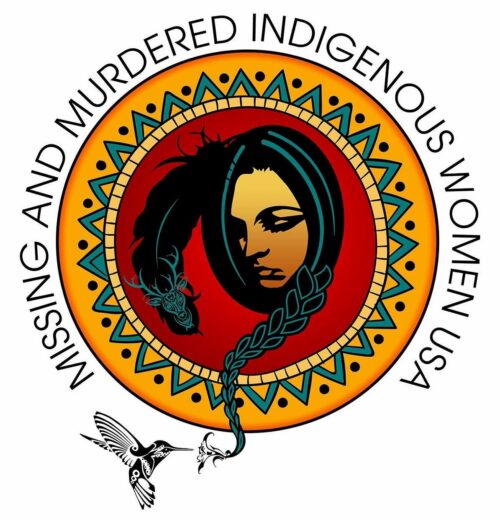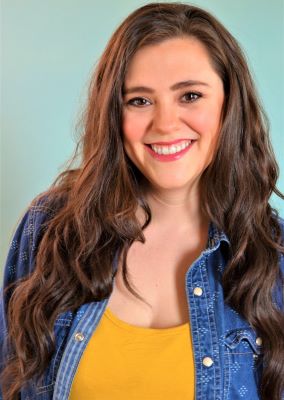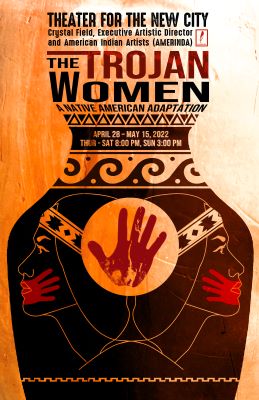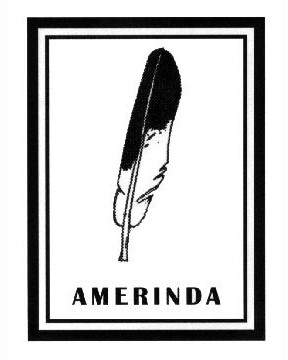INTERCONNECTEDNESS: A WAY OF SURVIVAL
Recently, at Theater for the New City on the lower eastside of Manhattan, Executive Artistic Director Crystal Field and AMERINDA (American Indian Artists, Inc.) produced a Native American adaptation of the Greek tragedy The Trojan Women by Euripides. Since its inception in 1987, the mission statement of AMERINDA, as stated by Osage/Cherokee founder and director Diane Fraher, seeks to empower Native American artists. A world view shared by Native people sees the interconnectedness of all things, in the presence of the seen and the unseen, and the idea that the stories themselves are sacred. With themes of invasion, slaughter of man, and abandoned women and children left behind to bear the brunt of masculine aggression, it’s no wonder Euripedes’ The Trojan Women has been revived throughout the ages.
Ellen Stewart’s La Mama production in the 1970s spoke to the Vietnam War, and a later production focused on 9/11. With this most recent production, one might expect the focus to be on the invasion and destruction of Ukraine by Russia’s autocratic leader. But Russia’s war is too new for that obvious setting. Instead, AMERINDA looked all the way back to the U.S.A.’s tragic beginnings, at the genocide of our tribal natives.
To adapt the script and direct the production, Sarah B. Denison was hired to take the helm. Born and raised on the Spokane Reservation, she grew up with the arts on both sides of her family. Her grandfather was a performer, and, on her mom’s Irish Scottish side, she had an aunt who was an opera singer. Later, she went to college at Eastern Washington University where she earned a BA in Theater Arts and practiced every aspect of theater. Post-graduation, her acting credits hit a high when she was cast and directed by Patti Duke to play Anne Sullivan in a west coast production of The Miracle Worker. From there, she made her way to New York, where her career in acting has continued to blossom along with a new focus in directing. Stage and Cinema met with Ms. Denison during the run of The Trojan Women, which is playing through May 15, 2022.
Gregory Fletcher / Stage and Cinema: How were you brought into AMARINDA?
Sarah B. Denison: The indigenous theater community is a small one in New York. We all seem to know one another. I had acted in a staged reading (just prior to the pandemic) where I met John Scott-Richardson, and later he asked me to do a few other readings. He introduced me to Diane, the founder and director of AMARINDA, who started the whole process for The Trojan Women. In a way, I think she went out on a limb with me, having never worked with me before, and I’m grateful for her trust in allowing me to take on this project. Then along came the creative team who all did a fabulous job: Kanako Nagayama, sets; Marsh Shugart, lights; Mary Symczak, costumes; Niez Aguirre, make-up; Hannah Louise Barnard, choreographer.
GF: I take it you had a few months to focus on the adaptation before stepping in to direct?
SBD: No, because we were stepping into a slot that had to be abandoned, rentals and schedules had already been made. I spent a few weeks on research and adapting the original script, and then we had a little over three weeks total for the actual rehearsal process with the actors. At first, I didn’t know to what extent the adaptation [would go]. Just sets and costumes to reflect a native culture? But once I started studying the play, I knew we had to do much more. When I originally read the play in college, I didn’t connect with it much, but reading it with more of an indigenous perspective, I had a much more emotional response to it, and ideas began to flow. I was still finishing the adaptation when we started casting. And then we jumped right into rehearsals. The writing process could’ve been afforded at least six months to complete. But we just didn’t have the time, so everything pretty much happened at the same time: casting, working with designers, and starting rehearsals.
Johnette Janney & April Hayden in The Trojan Women
GF: What came first in the adaptation?
SBD: At first, I was hesitant to take it on — I doubted whether I had the expertise or the confidence to really do it right. But first things first, I started to research the Greek history and comparing it to my Spokane tribal history. Paying purposeful respect to the original text, I decided I wanted to cut enough from the script to make the run time be around 90 minutes without an intermission.
Warren Seyler, Spokane Tribe historian
GF: What kind of research did you have access to, regarding the history of your Spokane tribe?
SBD: I reached out to Warren Seyler, the Spokane Tribe historian, who shared a lot of details I was specifically looking for. I wanted to change the names of the characters in the script, but I didn’t want to just use some fake native names. I wanted to use historical figures in the Spokane tribe who had similar personalities and qualities to that of Euripides’ characters. As you can imagine, the internet doesn’t have a lot of that information — just generic stuff that barely scratches the surface of most things. Warren had the expertise and the specificity I needed. He also has a YouTube channel that’s full of amazing videos about the history surrounding the battle of 1858. I decided to set the play in that time because of the amount of gathered historical information. We also discussed musical choices, all of which came specifically from the tribe. Could I use them for a theatrical production? Would I have the artistic freedom to use tribal names even when the story veered from the actual history? One of the names used in the adaptation is Slough-Keecah who is commonly known as Spokane Garry. I needed to take liberties to make the story work the way I needed it to work. Lucky for me, Warren was very open to it. I was so grateful to have somebody willing to speak with me and share so many stories. Native Americans are amongst the original storytellers, you know, so I was very blessed to tap into his expertise.
Ria Nez, Lee Taylor, Johnette Janney, April Hayden & Amada Arroyo in The Trojan Women
GF: Was it hard casting the production?
SBD: Yes and no. Many of the actors we had in mind were in the union, but for this project, we had to go non-union. I knew Hecuba needed to be at least in her 40s, if not older, but a lot of the women we reached out to within that age range were otherwise engaged. AMERINDA had a list of actors in the community they’d worked with before, but we had to cast a wider net for this production. In the end, it ended up being really wonderful because we brought a lot of people into the production that had never worked with AMERINDA before. Some had never acted before, so it gave us an opportunity to bring more people into the indigenous art community. We used not only Indigenous people of the United States, but also Indigenous Canadians, and members of the Indigenous communities of Central America and Puerto Rico. We have an all-indigenous cast. [Matt Cross, Jolie Cloutier, Annalisa Noel Hardin, Johnette Janney, Matt Langer, and Ria Nez; plus Amada Arroyo, April Hayden, Taniuska Lopez, Sybelle Silverphoenix, and Lee Taylor.] When we got together for a first read through, I sat and listened to them and thought, they’re all so fabulous — a perfect cast and a perfect blend of both people new to the stage and those with more experience. Because so many had day jobs, we could only rehearse in the evenings from 6:30 to 9:30, and not every day at that.
GF: That’s not even half the time a professional company would’ve had. Amazing. They were lucky to have an accomplished actress guiding them. I take it you’re proficient if Patty Duke cast you as Anne Sullivan and directed you in The Miracle Worker. What are your memories of working with Patty Duke?
SBD: When I was cast, I didn’t know who she was. My grandmother was a huge fan of The Patty Duke Show on television and freaked out. She was always very humble to us, and she often worked in the local community theater in Spokane. Everyone knew her. In a way, she was just one of our community members, so it was hard to think of her as a major celebrity. Looking back at it now, it was quite a special experience, and I am so grateful to have had the opportunity to learn from her.
Sarah B. Denison in the short film Ms. Connections
GF: Is your production of The Trojan Women attracting the indigenous community to the performances?
SBD: I hope it’s bringing everyone out because Native stories aren’t only for Indigenous people. It’s nice to be able to share these stories because so many people only understand Native Americans based on the stereotypes of Hollywood films. There are misconceptions about all kinds of different cultures in our society, and sharing our stories in the theater is a wonderful way to come together and shine light on those misconceptions. Not only to watch a story but also to walk away a little more connected as human beings — part of this web of humanity.
GF: What was your biggest challenge as a director with such limited rehearsal time?
SBD: Having such a short process was okay for me because I didn’t have time to second-guess what I was doing. Sometimes when you spend too much time on a scene, it becomes too intellectual, and you’re not going off your gut feelings and emotions as much. For me, I’m a very indecisive person, which can give too much time to wander around. But that said, I wished I could’ve had a little more time to work some of the scenes and to allow the actors more time to get a sense of ease, allowing them to feel more supported, to get a few more run-throughs in — things like that.
Ria Nez, Johnette Janney & April Hayden in The Trojan Women
GF: One of my favorite directorial choices of yours was when a woman was being taken from the stage, gagged with a white bandana with a hand painted on it. To stifle her words, I take it. Can you talk a little about this choice and where it came from?
SBD: This choice was made in reference to (and to bring awareness to) the Missing and Murdered Indigenous Women (MMIW) movement. I liked the idea of it being a “silencing” of the women, but also I wanted to bring attention to the movement and the fact that the violence toward Indigenous women began the moment our shores were invaded. This violence continues today. The white bandanas with the handprint over their face felt like a beautifully artistic way to accomplish this. According to collected data, Native American women are up to 10 times more likely to be murdered or sexually assaulted than any other group. Due to all kinds of jurisdictional things, their perpetrators are less likely to receive justice. The MMIW movement has expanded to include Missing and Murdered Indigenous Woman and Girls, Missing and Murdered Indigenous Women, Girls, and 2 Spirit People, and Missing and Murdered Indigenous Relatives. I hoped that the audience, if they didn’t recognize the symbol (the red handprint) of the movement, that they will be curious enough to look it up and become educated about its meaning.
 GF: It was a very special choice. How do you connect the women of Troy with Native women of Spokane? Are they interconnected?
GF: It was a very special choice. How do you connect the women of Troy with Native women of Spokane? Are they interconnected?
SBD: I think there are a lot of parallels between Euripides’ women and the Native women in the time of colonization. In both instances, the women were stripped of everything — culture, land, and their way of life. Such parallels made the connections come easily. We are connected to everything around us — to the Earth, to animals, to plants, and nature. With Native stories, there’s a rich history of understanding our place within the web of existence, understanding that we are a part of it, but we’re not in control of it. We’re not in charge. We’re here with the animals; we’re here with the land, with the planet, with the water, and we all have a part to play that isn’t more important than any other part. I think a lot of native storytelling does a nice job reminding us of this. In the original Greek script, the blame is put on the gods, almost as if it is all out of our hands. I specifically wanted to focus here on colonization and place the blame where, I feel, it belongs — on the greed of men (specifically the colonizers). But for me, it’s really about these women who survive and continue their culture against all odds. This interconnectedness is a way of survival. It’s not only a way of life but also a tool for survival.
GF: That’s a beneficial message, given our own times as well. Thanks so much, Sarah.
Matt Langer in The Trojan Women
production photos of The Trojan Women by Marlene Flores
The Trojan Women: A Native American Adaptation
AMERINDA Theater
Theater for the New City/ Cabaret Theater, 155 First Avenue
for tickets ($15-$18), call 212.254.1109 or visit Theater for the New City
Thurs-Sat at 8; Sun at 3 | ends on May 15, 2022
for more info, visit Sarah B Denison



